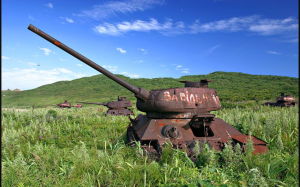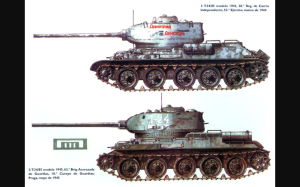 In this second part we will discuss the effectiveness of the T-34, which, like all tanks, had its strengths and weaknesses. (see part one)
In this second part we will discuss the effectiveness of the T-34, which, like all tanks, had its strengths and weaknesses. (see part one)
The strengths were its armor, firepower and mobility. Its weaknesess were handling, ergonomics, layout and visibility of the crew (commander and driver).
The T-34 had great stability on its strengths throughout WW2. In 1941, when it appeared in battle what surprised more that the enemy was its sloped armor which could not be penetrated by enemy anti-tank weapons, only 88 mm Flank could do it at short distances with short 50 mm cannons.
 Most German tanks of 1941 only had smaller caliber cannons. It was 37 mm and 50 mm versus 76 mm T-34, but this changed in mid-1942 when the Germans improved their weapons and T-34 began to be vulnerable for the rest of the conflict, but it still had better armor than the M4 Sherman and Panzer IV. Although that weakness was improved from 1943 on with the arrival of T-34/85.
Most German tanks of 1941 only had smaller caliber cannons. It was 37 mm and 50 mm versus 76 mm T-34, but this changed in mid-1942 when the Germans improved their weapons and T-34 began to be vulnerable for the rest of the conflict, but it still had better armor than the M4 Sherman and Panzer IV. Although that weakness was improved from 1943 on with the arrival of T-34/85.
In firepower, the barrel 76 mm T-34 penetrated any 1941 German tank with ease. With the ZIS-5 they could penetrate armor of 102 mm ammunition calibrated at 90 or 100 meters. and armor of 78 mm at 90 to 500 meters with BR-350A shells, it could also fire high explosive. In 1943, it began to struggle against the scope of the Panther 75 mm or 88 mm of Tiger I. The arrival of the 85 mm cannon to T-34 in 1944 did not reach Germans’ firepower, but at least they could penetrate them at reasonable distances, while the price and mobility of the T-34/85 was much better than the German tanks. On the other hand it also allowed frontally drilling these with tungsten core ammunition which could penetrate 138 mm at 500 meters, sufficient distance against the Panther and Tiger I.
Regarding mobility, wide tracks of T-34, its good suspension and great engine gave them performance in all types of terrain unparalleled German tanks first generation could not achieve this performance, because of their narrow tracks did get stuck and unable to maneuver in places where the T-34 could go with ease.
In short, T-34 hardness made it one of the best tanks in the first half of the conflict. We should also take into account its operativity, it was 70-90% in 1943 compared to 48-62% of Germans.
Moreover their weaknesses
First the very poor ergonomics it had despite the improvements made. In the versions mounting cannon 76 mm turret there was only room for two people it was so narrow. The visibility of the commander in small battle, the terrible hatch opening, which opened frontally, forced it to use a visor and a horizontal periscope to see the ground, in addition to having to handle functions of charger. German, British and American tanks owned turrets for up to three men, so that the commander was only dedicated to that, to command the platoon. The problem was solved with the new turret T-34/85.
Driver visibility was too bad, some of them reported that the hatch was kept slightly open even in combat because of terrible visors mounted on his battle, this affected the performance tactically because they had a wide view of the field.
The position of the ammunition in metal boxes has its problems as the floor of the turret was designed for the storage of ammunition in tins of 9 shells each which made time cannon recharge greatly slowed as the ammunition stocks lowered.
There were many other poor factors: training of crews, entering combat with basic training and two days of preparation in vehicle handling, lack of appropriate controls (specially after Stalin’s purges), lack of radio in the early models so that commanders could not communicate with the rest of the platoon, etc. But they were vital to the Red Army, as its production did not decline and allowed them to always have numerical superiority over the Germans.
The next battle tank to be treated in this section will be the American M4 Sherman tank.
Author: Escipionelafricanus_ps, Pedro.
Translated by: ElCidCampeador2014, Wayne or Rafa












Un comentario en “Tank T-34/76 and T-34/85 (Part 2)”